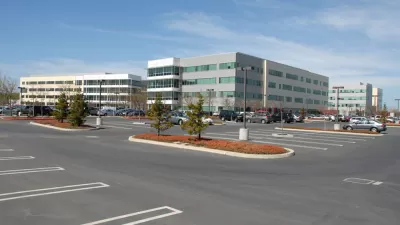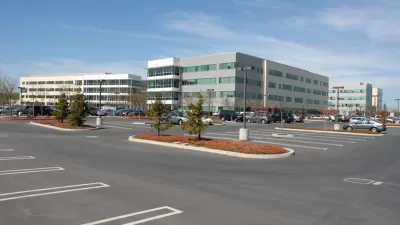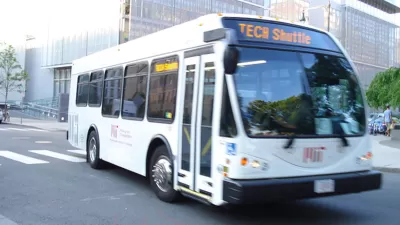The office park has become a suburban given, disliked by some, but once it represented a utopian vision of work away from the city. Here's a look at how the Silicon Valley model developed, and where it might be going.

Benjamin Grant discusses how industry and commerce followed housing's path into suburbanization. "It is not uncommon for tourists to go looking for Silicon Valley only to find themselves lost and disappointed in an ocean of asphalt, and to content themselves with a selfie in front of the Googleplex driveway."
Many of us have fallen out of love with suburbs today, but in the mid 20th-century, office parks promised a working future away from the noise and pollution. "In various ways, research parks replicated the suburban planning and design controls pioneered in the city of Menlo Park in 1948, deliberately presenting an alternative to industrial factories, where most research and development functions had traditionally been housed."
Fairchild Semiconductor, among other firms, pioneered this shift to "clean industry," which initially stoked the concerns of nearby residents enjoying their suburban lifestyle. "To overcome incipient local opposition, suburban enterprises were vigorously marketed as 'smokeless' industries – the very antithesis of polluting urban industries. Zoning was created to facilitate commercial uses while safeguarding suburban character."
Those first forays grew into the modern office park, a profitable and adaptable model. "Large, horizontal floors and open plan spaces could be quickly occupied and reconfigured by fast-moving teams. This building strategy allowed companies to grow quickly in discrete and predictable units and then contract just as quickly by shedding them."
Grant also goes into recent trends, including both a return to the city by several large firms (Airbnb, Yelp, and Salesforce among them), as well as the opposite: giant "prestige campuses" like Apple's upcoming headquarters (budgetary estimates hover at $5 billion). And then there are hybrids from Samsung and Box, bringing urban design principles into suburban surroundings.
FULL STORY: The Corporate Campus: A Local History

Planetizen Federal Action Tracker
A weekly monitor of how Trump’s orders and actions are impacting planners and planning in America.

Maui's Vacation Rental Debate Turns Ugly
Verbal attacks, misinformation campaigns and fistfights plague a high-stakes debate to convert thousands of vacation rentals into long-term housing.

San Francisco Suspends Traffic Calming Amidst Record Deaths
Citing “a challenging fiscal landscape,” the city will cease the program on the heels of 42 traffic deaths, including 24 pedestrians.

Amtrak Rolls Out New Orleans to Alabama “Mardi Gras” Train
The new service will operate morning and evening departures between Mobile and New Orleans.

The Subversive Car-Free Guide to Trump's Great American Road Trip
Car-free ways to access Chicagoland’s best tourist attractions.

San Antonio and Austin are Fusing Into one Massive Megaregion
The region spanning the two central Texas cities is growing fast, posing challenges for local infrastructure and water supplies.
Urban Design for Planners 1: Software Tools
This six-course series explores essential urban design concepts using open source software and equips planners with the tools they need to participate fully in the urban design process.
Planning for Universal Design
Learn the tools for implementing Universal Design in planning regulations.
Heyer Gruel & Associates PA
JM Goldson LLC
Custer County Colorado
City of Camden Redevelopment Agency
City of Astoria
Transportation Research & Education Center (TREC) at Portland State University
Jefferson Parish Government
Camden Redevelopment Agency
City of Claremont




























